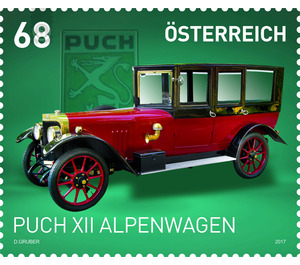automobile - Austria / II. Republic of Austria 2017 - 68 Euro Cent
Theme: Traffic, Transportation & Mobility
| Country | Austria / II. Republic of Austria |
| Issue Date | 2017 |
| Face Value | 68.00 |
| Edition Issued | 200,000 |
| Perforation | 13¼ x 13¾ |
| Printing Type | offset |
| Stamp Type | Commemorative |
| Item Type | Stamp |
| Chronological Issue Number | 2681 |
| Chronological Chapter | OOS-OE2 |
| SID | 95658 |
| Dimensions | 35.00 x 42.00 |
| In 72 Wishlists | |
Almost 100 years ago, in 1919, the Puch Alpenwagen XII was developed - a further development of a car from the monarchy. As early as 1889, Johann Puch (1862-1914) started his own small bicycle production in Graz after having learned the craft of locksmithing. Ten years later he founded the "Johann Puch Erste Steiermärkische Fahrrad-Fabriks Aktiengesellschaft", which was renamed Puchwerke AG in 1914. Johann Puch died in the same year. The Puchwerke merged in 1928 with the Austrian Daimler-Motoren-Gesellschaft and became the Austro-Daimler-Puchwerke AG, a short time later it became the Steyr-Daimler-Puch AG. In 1998, Magna Holding took over those areas that had not yet been spun off or sold, and today is primarily concerned with drive technology. As early as 1900, Johann Puch was not only concerned with bicycles, but also with motorized vehicles. He built a motor in a three-wheeled bike and made it the prototype of a motorcycle. Many automobiles or two-wheeled classics from the house of Puch originated only long after Johann Puchs death, including the still legendary Puch 500, the Haflinger or the Puch Maxi, the last Puch moped, which was produced from 1965 to 1995. The Alpine car XII is also often referred to as a "small Alpine car", in contrast to the "big" Alpenwagen VIII. This was actually designed for the Austrian Alps - hence the name Alpenwagen -, but was used during the war mainly as a medical vehicle. The "big" Alpenwagen was built from 1913 to 1922 and had a 3.5 liter four-cylinder engine with 38 hp. The "small" Alpenwagen XII was equipped with a four-cylinder inline engine with 22 hp and 1,488 cubic centimeters, so had about half the power of the Alpine Car VIII. It was produced only from 1919 to 1920 with a number of 300 vehicles, only a few vehicles still preserved today. This makes the Alpine car XII a very special rarity.


